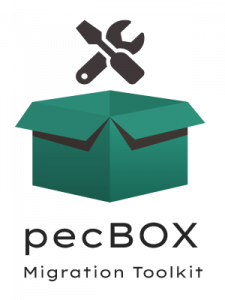SOFTWARE MIGRATION – A REAL ALTERNATIVE
A professionally realised software migration means
- safeguarding individuality, know-how and unique selling points
- paving the way for future-proof platforms and development environments
- opening up the modern world of information and communication
- preserving independence of proprietary manufacturers and licence products
- saving time and costs
Compared to a new development, a software migration has the decisive advantage that it requires less effort. Experience from several projects proves a ratio of 1:8. If a migration project has an expected scope of 15 man-years (which is a quite common time span), for example, about 120 man-years would have to be calculated for a development from scratch.
A software migration usually embraces all components of a legacy system (programmes, screens, files, jobs, middleware, databases).
The graphic shows the migration paths supported by us and the software tools used accordingly.
Over the last 30 years, we have successfully realised migration projects – on time and on budget. Naturally, our experience gained over the years flows into current and future migration projects.
OUR TOOLS AND TECHNOLOGIES
A software migration can only be managed with sophisticated migration tools and technologies.
Our unique selling point is the consistent application of scientific compiler-building methods in the development of technology and tools, resulting in a high level of automation. This in turn reduces the project duration, project costs and error rate in contrast to manual migration. Our tools and technologies support all components of a migration project (programmes, middleware, files/databases, screens, job control languages etc.).
Each migration project is unique. The pecBOX (pro et con – Toolbox for Software Migration) developed by us adapts migration tools and technologies quickly, flexibly and cost-effectively to individual customer needs.
OUR PROCESS OF A MIGRATION PROJECT
The individual steps are as follows:
- workshop: once you have shown interest in a joint migration project with us, we hold an all-day workshop together. Here, you can present your current legacy system and outline your requirements and ideas concerning a software migration. We will present our technologies and tools. If you provide us with selected sources of your system (e.g. COBOL programmes, screen descriptions, …), we will demonstrate the migration process based on your sources. In consequence, we will decide if the next step of the cooperation, which involves the preparation of a study, will be made together.
- study: having agreed on further cooperation, we will prepare a study which will essentially touch on the following points:
- detailed compilation of the legacy system to be migrated, including its application statistics
- defining the target system (hardware, architecture, application server, programming and script languages, frameworks etc.)
- identifying the migration paths between legacy and target systems. Among other things, the effort needed to adapt the existing tools to the concrete project requirements or, as the case may be, to develop new tools, is assessed.
- outlining the distribution of tasks required for the project between the partners concerned
- determining the effort (costs) and duration of the project as essential results of the study
- pilot project: based on the results of the study, a pilot project (proof of concept) will be initiated, which will implement a vertical prototype (screen, server, database) at a selected subset of approximately 20 % of the legacy system in order to verify the chosen migration technology and the tools used. Depending on the outcome, these tools are readjusted if needed.
- pre-engineering: in parallel to the pilot project, you will clean up the system to be migrated (“pre-engineering before migrating”). In this step, the term “pre-engineering” means that re-engineering tasks are carried out ahead of the actual migration. Experience from previous projects has shown that the application statistics to be migrated are reduced by approximately 10–15 %.
- migration project: after these steps of systematic preparation, the joint migration project is launched. We offer this for a fixed price, identified in the study. During the migration project, no code freeze is required. Programmes that have already been migrated and are subject to further development as part of general maintenance can be migrated again at any time. This ensures a continued maintenance and an uninterrupted operation of your existing system. Upon project completion, both the original programme system and the system resulting from the migration have an identical, up-to-date development status.
-
refactoring: in the course of numerous migration projects, we have developed a comprehensive tool, which allows the automatic refactoring of Java code after a migration. This means that, even years after a completed project, you are able to react flexibly to new requirements.
All of our previous projects have been completed successfully – on time and on budget.
“Von JOBOL zu JAVOL – Refaktorisierung migrierter Java-Programme”
Abstract for 25th “Workshop Software-Reengineering & Evolution” 8–10 March 2023 in Bad Honnef, published in:
Softwaretechnik-Trends, volume 43, part 2, May 2023
“Migration des Südleasing COBOL-Kernbanken-Systems nach JAVA mit einem iterativ-inkrementellen Ansatz”
Abstract for 24th “Workshop Software-Reengineering & Evolution” 2–4 May 2022 in Bad Honnef, published in:
Softwaretechnik-Trends, volume 42, part 2, May 2022
“Jedes COBOL-Java-Migrationsprojekt birgt neue Überraschungen”
Abstract for 24th “Workshop Software-Reengineering & Evolution” 2–4 May 2022 in Bad Honnef, published in:
Softwaretechnik-Trends, volume 42, part 2, May 2022
“Toolbasierte Software-Migration nach Plan”
Abstract for 18th “Workshop Software-Reengineering & Evolution” 2–4 May 2016 in Bad Honnef, published in:
Softwaretechnik-Trends, volume 36, part 2, May 2016
“Aus Alt mach Neu – automatisch! Migrationsprojekte erfolgreich planen und realisieren”
Article by Dr. Uwe Kaiser (pro et con), published in:
Business Technology, release 03/2014, page 41
